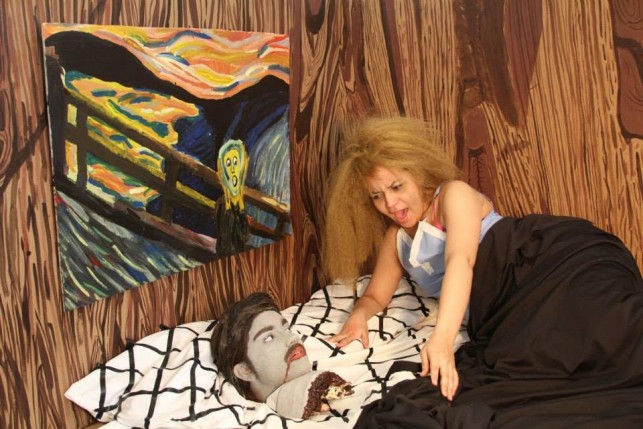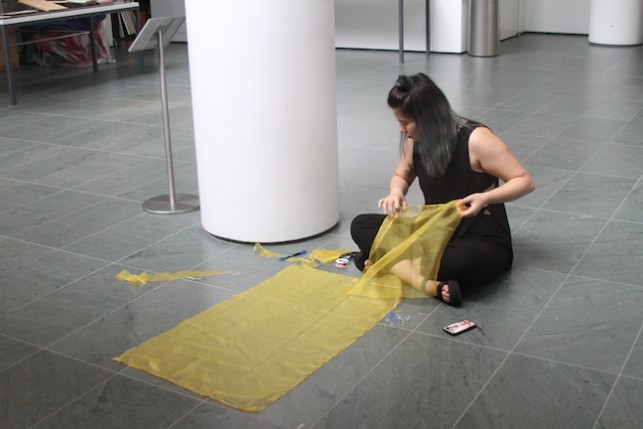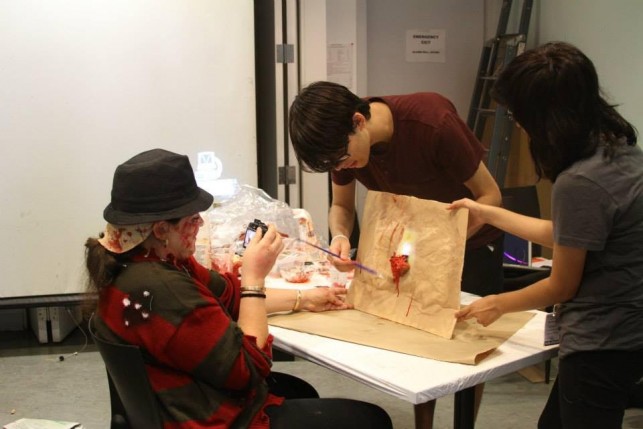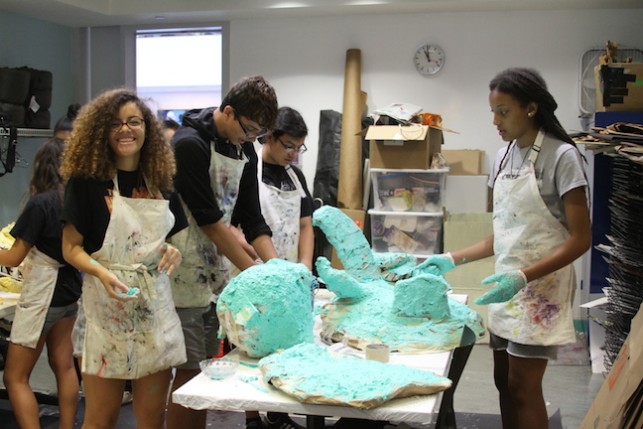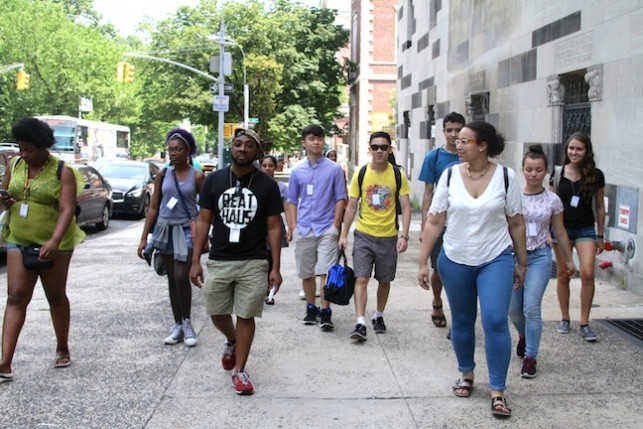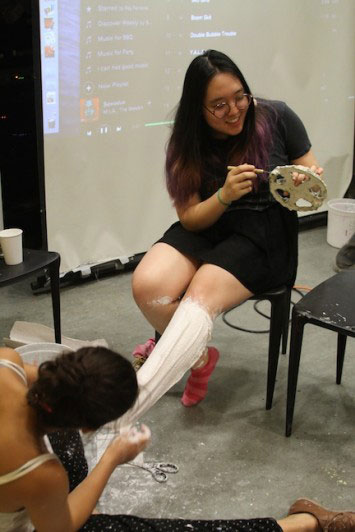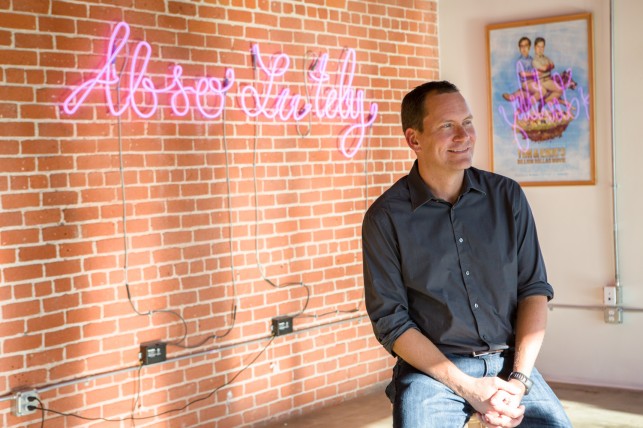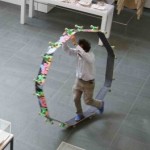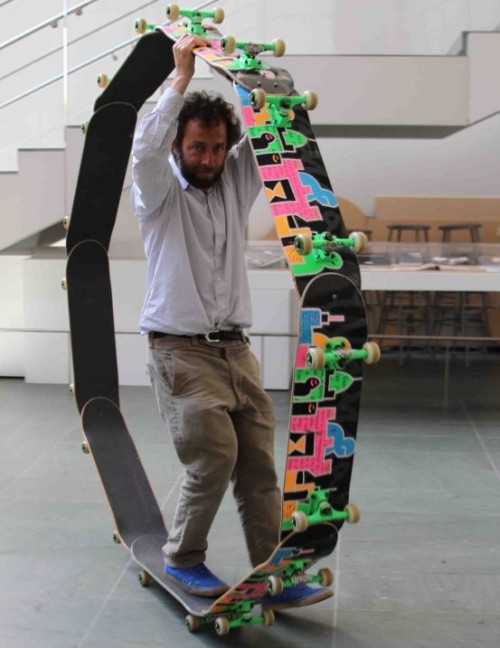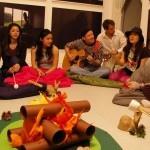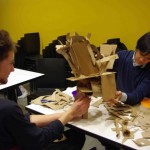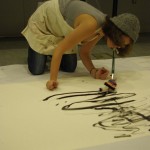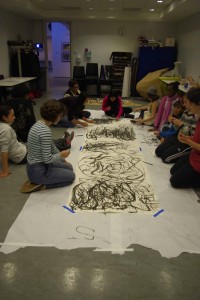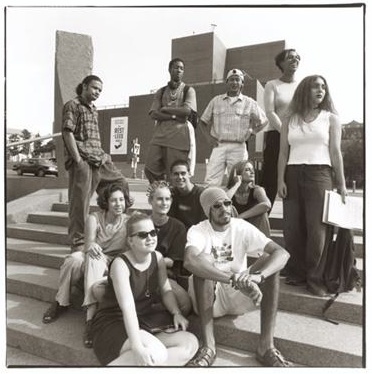The first day of class is always the worst. This summer’s In the Making program was no different. At nearly 10:00 a.m. on a sunny Tuesday morning in July, our new group of teens shuffled into the Museum silently, diverting all eye contact and slouching in their seats as if it made them invisible. But I knew them more than they realized. I’d carefully read each of their applications and typed their first and last names onto the official MoMA Teens ID cards they would receive as a first day rite of passage. Beneath their apprehensive facades, I knew they had shown up longing for a creative experience unlike any they had participated in thus far.
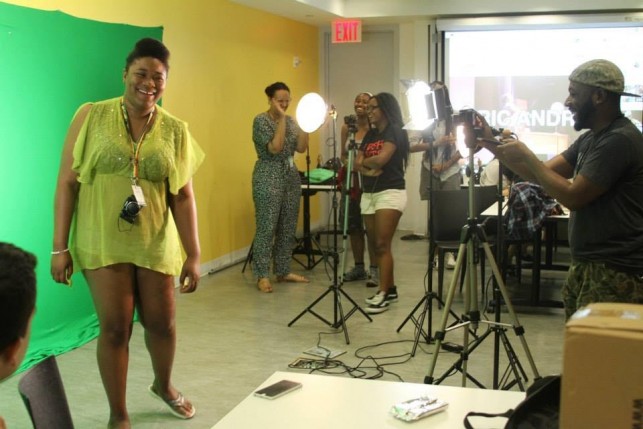
Loosening up with green screen photography in CLICK@MoMA: Sight + Sound Lab. Photo by Kaitlyn Stubbs
Before beginning my role assisting with all of the different aspects of MoMA’s teen programming two years ago, I taught traditional oil painting and figure drawing workshops at the Museum of Fine Arts, Boston. There, I witnessed the ways learning technical skills can empower students through providing the tools and confidence to visually represent the world around them. In MoMA’s In the Making programs, I’m seeing how a menu of experimental and nontraditional courses empowers students in exciting and different ways. In the spirit of the modernist artists in MoMA’s collection, our teen programs challenge and deconstruct the academic and traditional values that many NYC youth (and people of all ages) still firmly cling to when analyzing artistic quality and intent. We shake up their world, and the shy adolescents from the first day emerge totally unrecognizable after six short, intense weeks in the Museum.
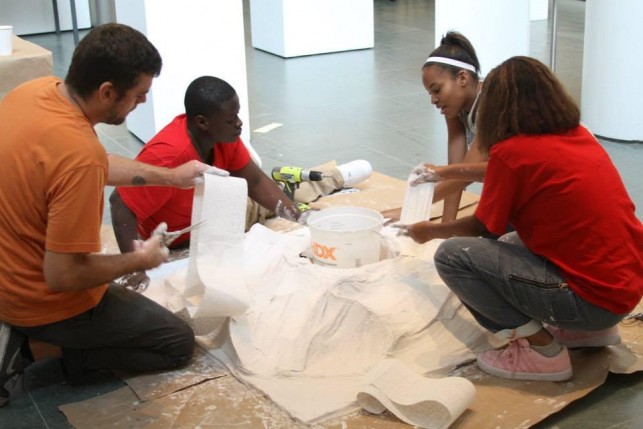
You Think This Is a Game?! artists making a Lee Bontecou–inspired mini-golf course. Photo by Kaitlyn Stubbs
This summer’s course offerings included You Think This Is a Game?!, which tackled sculpture through the lens of physicality, competition, and the antihero; Jaimie Warren’s House of Horror, which made comically gory GIFs re-creating horror clips and an elaborate cardboard kitchen installation exploring DIY techniques and the boundaries of good taste; The Surreal World, in which students delved into the subconscious through automatic drawing, assemblage, dream journaling, and the absurd; and CLICK@MoMA: Sight + Sound Lab, which involved creating audio and video mash-ups and album covers, many influenced by the visual culture of 1990s hip-hop and political events of our time.
Some might question the value of “scribbling” all over the walls or making crude sculptures with cardboard and tape. “How does that sharpen their artistic skills?” they might ask, or, “How does that experience prepare them for the real world? Why should they spend their summer in a studio when they could be prepping for the SATs?”
Personally, I also became seriously involved in art as a teenager. Growing up in suburban Atlanta, I always did well in class but often felt like I was just going through the motions. Art class was the one place where things weren’t simply wrong or right. This created an exciting challenge that led me to new and less narrow modes of thinking. In art class, I was fortunate to find a community that introduced me to the beauty of subjectivity, expression, and interpretation. It was an eye-opening, liberating moment in my development, and facilitating similar experiences for our young participants is a constant aim of mine.
Many of the teens I encounter are so accustomed to measuring themselves against their peers in one way or another, and it can be difficult to move beyond the binaries of good/bad or skilled/unskilled that are already rooted in their minds. I can relate, as it can be easy for me to slip back into this prosaic mode of thinking if I don’t actively keep it in check. Something I frequently find myself telling students (and myself) is, “Don’t compare yourself to others.” As basic and obvious as this statement sounds, I’m discovering it’s one of the most effective and empowering.
In the Making aims to nurture very different kinds of skills than AP Art History or some academic figure drawing course might provide. Not because one type of skill is better than the other, but because they are equally valid. Our students don’t receive a certificate or school credit for their time with us, but they continue to come to the studio day after day to make cool stuff. Our classes may appear messy, chaotic, and strange, but this is exactly what creates an open-ended and playful space, nurturing new and overlooked skills such as radical thinking, idea execution, collaboration, and more. I feel our efforts to distance the program from the realms of grades, status, and measurability is the key to creating the transformative experiences and tight-knit communities I’ve seen emerge season after season. This open-endedness is one of the true gifts of the program, especially considering NYC is a city where students begin standardized testing in early elementary school. Freedom to experiment is not simply a perk of In the Making, but its lifeblood.And just as the first day of class is the worst, the last week of classes is almost always the best, as the profound shift that took place over the past 18 sessions of studio time becomes intensely palpable. On the final day of class this summer, teen artists confidently occupied MoMA’s studio spaces, grabbing supplies and claiming whatever corner of the room they needed to frantically hammer the last nails into their sculptures or make the final edits on their video mash-ups. Playlists boomed out of the speakers, surrounding the buzzing chitchat of a focused and lively group. Some were having an intense critique in the mezzanine, while others decided to trash a piece they’d worked on for hours because they just weren’t feeling it anymore. When class time was up, no one wanted to leave.
At our Teen Art Show opening two days later, one of our exceptionally thoughtful In the Making and Cross-Museum Collective alumni, Priya, gave us a handwritten thank-you note. Part of it read:Before I left for school, I just wanted to let you guys know how thankful I am for the MoMA Teens education program. I truly do mean it when I say that being a MoMA Teen has changed my life. I don’t know if I’d even be studying art in college if it wasn’t for the confidence that MoMA Teen programming has given me…. Since my In the Making class last summer, I found my passion for art, discovered the teen art community in NYC & all the events available to me, learned more that I could ever imagine about the MoMA (aka my favorite museum in the universe), made friends who share the same passion as me & gained the confidence to pursue a career in the art field.
Beyond being rewarding and heartwarming to read, Priya’s note sums up the experience we hope to create for all of our participants. It is not our goal to have every student we work with go on to study art in college. But instilling confidence, rethinking possibilities, nurturing skills to execute ideas, and building communities will enrich any young person’s life, regardless of the path they pursue.
Extra special thanks to Calder Zwicky, Ali Santana, Zephyr Doles, Jaimie Warren, Sofia Dixon, Keith Mendak, Ray Ferreira, Leah Wolff, Esteban Jefferson, Guy Ben-Ari, Matt Roche, Adam Tetzloff, Chris Annibell, and OP Miller.



